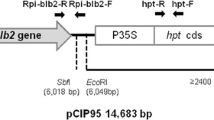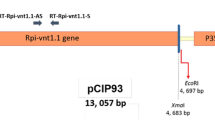Abstract
The coding sequence from the pea disease resistance response gene 49 (DRR49 gene), was transferred into the potato (Solanum tuberosum L.) cultivar Shepody viaAgrobacterium co-cultivation. Potato leaf explants were co-cultivated withAgrobacterium tumefaciens harboring a binary vector containing the coding sequence from the DRR49 gene under the control of the 35S promoter from cauliflower mosaic virus (CaMV). Transformed potato plants were selected by their resistance to kanamycin. The insertion of foreign DNAs was detected by polymerase chain reaction (PCR) and Southern blot analysis. The expression of DRR49 coding sequence was confirmed via the detection of the corresponding mRNA in northern blot analysis. Field pathogenicity tests indicated that transgenic plants expressing the pea DRR49 mRNA have higher tuber yields than the control plants when grown in PED (potato early dying) infested soil.
Compendio
La secuencia de codificatión del gen de respuesta 49 (gen DRR49) de la resistencia a una enfermedad de la arveja, fue transferida al cultivar de papa (Solanum tuberosum L.) Shepody por intermedio de un cultivo conjunto conAgrobacterium. Cortes de hoja de papa fueron cultivados conjuntamente conAgrobacerium tumefaciens portando un vector binario conteniendo la secuencia de codificación del gen DRR49 bajo el control del promoter 35S del virus del mosaico de la coliflor (CaMV). Las plantas transformadas de papa fueron seleccionadas por su resistencia a la kanamicina. Se detecto la insertión de DNAs importados por medio de la reacción en cadena de polimerasa (PCR) y el análisis del DNA en membranas de nitrocelulosa (“Southern blot analysis”). La expresión de la secuencia de codificatión del DRR49 se confirmó mediante la detection del correspondiente mRNA en análisis sobre membranas de nitrocelulosa (“Northern blot análisis”). Pruebas de patogenecidad en el camp indicaron que las plantas transgénicas expresando el DRR49 raRNA de la arveja tienen rendimientos en tubérculos mayores que las plantas testigo cuando crecen en suelos infestados con muerte prematura de la papa (PED = potato early dying).
Similar content being viewed by others

Abbreviations
- MS:
-
Murashige and Skoog
- NAA:
-
naphthaleneacetic acid
- CAT:
-
chloramphenicol acetyltransferase
- DRR49 gene:
-
disease resistance response gene 49
Literature Cited
An, G.. 1987. Binary Ti vectors for plant transformation and promoter analysis. Methods in Enzymology 153:292–305.
An, G., P.R. Ebert, A. Mitra and S.B. Ha. 1988. Binary vectors.In: Plant Mol Biol Manual: Gelvin, S.B and Schilperoort, R. A. Ed. pp. 1–19, Kluwer Academic Publishers, Dordrech, The Netherlands.
Chiang, C.C. and L.A. Hadwiger. 1990. Cloning and characterization of a disease resistance response gene in pea inducible by Fusarium solani. Mol Plant-Microbe Inter 3:78–85.
Daniels, C.H., B. Fristensky, W. Wagoner and L.A. Hadwiger. 1987. Pea genes associated with non-host resistance to Fusarium are also active in race-specific disease resistance to Pseudomonas. Plant Mol Biol 8:309–316.
De Block, M. 1988. Genotype-independent leaf disc transformation of potato (Solarium tuberosum) usingAgrobacterium tumefaciens. Theor Appl Genet 76:767–774.
Fourney, R.M., J. Miyakoshi, R.S. DayIII and M.C. Peterson. 1988. Northern blotting: efficient RNA staining and transfer. Focus 10:5–7.
Fristensky, B., D. Horovitz and L.A. Hadwiger 1988. cDNA sequences for pea disease resistance response genes. Plant Mol Biol 11:713–715.
Fristensky, B., R. Riggleman, W. Wagoner and L.A. Hadwiger. 1985. Gene expression in susceptible and disease resistant interactions of peas induced withFusarium solani pathogens and chitosan. Physiol Plant Pathol 27:15–28.
Hadwiger, L.A. and W. Wagoner 1983. Electrophoretic patterns of pea andFusarium solani proteins synthesizedin vitro which characterize the compatible and incompatible interactions. Physiol Plant Pathol 23:153–162.
Hadwiger, L.A., C.C. Chiang, A. Pettinger and M.-M. Chang 1990. Strategy to improve disease resistance by transferring “non-host” disease resistance genes from peas to potatoes.In: Biotechnology and Food Safety Westhoff, D..et al. Ed. pp. 241–253. Butterworth-Heinemann, Inc, Boston.
Hadwiger, L.A., C. C. Chiang and D. Horovitz. 1992. Expression of disease resistance response genes in near-isogenic pea cultivars following challenge byFusarium oxysporum race 1. Physiol Mol Plant Pathol 40:259–269.
Hoekema, A., M.J. Huisman, L. Molendijk, P.J.M. van den Elzen and B.J.C. Cornelissen. 1989. The genetic engineering of two commercial potato cultivars for resistance to potato virus X. BioTechnology 7:273–278.
Hood, E.E., G.L. Helmer, R.T. Fraley, and M-D. Chilton 1986. The hypervirulence ofAgrobacterium tumefaciens A281 is encoded in a region of pTiBo542 outside of TDNA. J Bacteriol 168:1291–1301.
Ishida, B.K., G.W. Snyder and W.R. Belknap. 1989. The use of in vitro-grown microtuber discs in Agrobacterium-mediated transformation of Russet Burbank and Lemhi Russet potatoes. Plant Cell Rep 8:325–328.
Jefferson, R.A., T.A. Kavanagh and M.W. Bevan. 1987. GUS fusion: β-glucuronidase as a sensitive and versatile gene fusion marker in higher plants. EMBO J 6:3901–3907.
Lawson, C., W. Kaniewski, L. Haley, R. Rozman, C. Newell, P. Sanders and N.E. Turner. 1990. Engineering resistance to mixed virus infection in a commercial potato cultivar: resistance to potato virus X and potato virus Y in transgenic Russet Burbank. BioTechnology 8:127–134.
Mackenzie, D.J., J. H. Tremaine and J. McPherson, J. 1991. Genetically engineered resistance to potato virus S in potato cultivar Russet Burbank. Mol Plant-Microbe Inter 4:95–102.
Matton, D.P. and N. Brisson. 1989. Cloning, expression and sequence conservation of pathogenesis-related gene transcripts of potato. Mol Plant-Microbe Inrteract 2:325–331.
Murashige, T. and F. Skoog. 1962. A revised medium for rapid growth and bioassays with tobacco tissue cultures. Physiol Plant 15:493–497.
Murray, M.G. and W.F. Thompson. 1980. Rapid isolation of high molecular weight plant DNA. Nucleic Acids Res 8:4321–4325.
Rowe, R.C., J.R. Davis, M.L. Powelson and D.I. Rouse. 1987. Potato early dying: causal agents and management. Plant Disease 71:482–489.
Sheerman, S. and M.W. Bevan. 1988. A rapid transformation method forSolanum tuberosum using binaryAgrobacterium tumefaciens vectors. Plant Cell Rep 7:13–16.
Somssich, I.E., E. Schmelzer, P. Kawalleck and K. Hahlbrock. 1988. Gene structure andin situ transcript localization of pathogenesis-related protein I in parsley. Mol Gen Genet 213:93–98.
Stiekeman, W.J., F. Heidekamp, J.D. Louwerse, H.A. Verhoeven and P. Dijkhuis. 1988. Introduction of foreign genes into potato cultivars Bintje and Desiree using anAgrobacterium tumefaciens binary vector. Plant Cell Rep 7:47–50.
Wagoner, W., D.C. Loschke and L.A. Hadwiger. 1982. Two-dimensional electrophoretic analysis ofin vivo andin vitro synthesis of proteins in peas inoculated with compatible and incompatibleFusarium solani. Physiol Plant Pathol 20:99–107.
Walter, M.H., J.-W Lin, C. Grand, C. J. Lamb and D. Hess. 1990. Bean pathogenesis related (PR) proteins deduced from elicitor-induced transcripts are members of an ubiquitous new class of conserved PR proteins including pollen allergens. Mol Gen Genet 222:353–360.
Young, D.A., R.R. Tarn and H.T. Davies. 1983. Shepody: a long, smooth, whiteskinned potato of medium maturity with excellent French fry quality. Am Potato J 60:109–113.
Author information
Authors and Affiliations
Rights and permissions
About this article
Cite this article
Chang, MM., Chiang, C.C., Martin, M.W. et al. Expression of a pea disease resistance response gene in the potato cultivar Shepody. American Potato Journal 70, 635–647 (1993). https://doi.org/10.1007/BF02849153
Accepted:
Issue Date:
DOI: https://doi.org/10.1007/BF02849153



